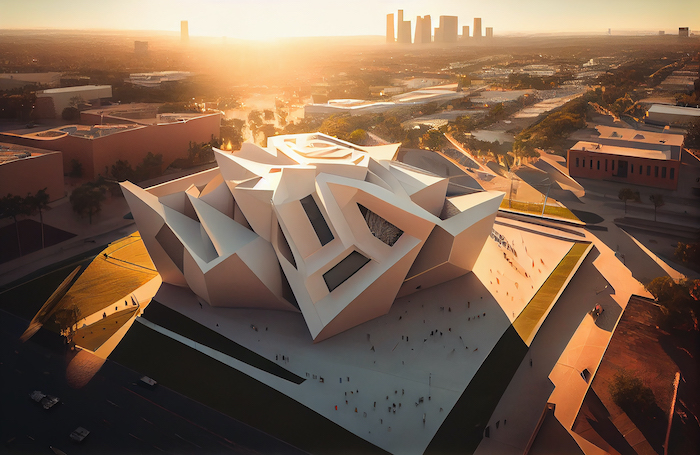This week, RIBA has published the findings from the first ever industry-wide survey of how architects are responding to Artificial Intelligence (AI) in the architectural profession. The results suggest that AI will be widely adopted and integrated into practice and is expected to deliver tangible benefits for the profession in the near term.
“AI adoption in practice stands at 41%, even though AI only arrived in the form of tools seen as accessible to non-specialist users a little over one year ago,” the findings say. “Significant numbers of practices report that they are using AI for at least the occasional project.”
The RIBA AI Report 2024 also includes a series of expert articles and case studies looking at how AI is reshaping practice, from computational design and digital fabrication to urban planning and environmental sustainability.
Around one in three practices say that they are actively developing their practice offering through AI, while a small but notable 11% consider themselves to be leading digital innovators. Nineteen per cent identify as early adopters of digital innovation.
So how are practices using AI, and what are they using it for?
Find out more about RIBA Academy’s AI in architecture module.

What are the four main ways architects are using artificial intelligence?
Des Fagan, Head of Architecture at Lancaster University and member of RIBA’s expert advisory group on AI says that the profession is currently in a kind of research and development (R&D) phase on AI. At this stage, nothing is quite proven in terms of future efficiency gains even though the assumption is that they will be major.
Des says AI used by practices tends to fall into four categories:
1. Design ideations
Probably the most widespread use of AI by practices is for visualisations for design ideations. Any licensed Photoshop user can now use its Generative Fill system, which is powered by Adobe’s Firefly AI engine, for instance. It offers everyone instant visualising skills.
So, if architects want to take an image section of a building and place it in a speculative landscape, perhaps add objects like people and cars, this can now be done with a few text prompts. Specialist rendering skills may no longer need to be outsourced for those practices not offering this service.
2. Concept designs
Image diffusion apps like Midjourney and Stable Diffusion can produce stunning concept design images from text prompts alone. However, Des regards the most interesting tool at the moment as D5 Render, which already integrates with CAD/BIM modelling systems such as Rhino, Revit, SketchUp and Archicad.
Architects can take their early stage models and apply stylistic iterations in real time, such as cycling through different materials types and different iterations of design ideation.
3. Text generation
ChatGPT is the AI chatbot that launched the AI avalanche just over a year ago. It is trained on generalised online data – with defined cut-off dates of scraped knowledge dependent upon the version – that can be used as a research tool and text generator/editor, again only responding to a series of refinable text prompts.
Practices are using ChatGPT for writing and rewording reports, summarising ideas for client presentations, fee proposals, planning applications and administrative tasks such as HR processes.
4. Practice archiving
Large practices – with an R&D budget - are starting to apply machine learning to their own data sets in order to train AI engines purely on their back catalogue of designs, their design approaches and stylistic methods, and their own libraries of information.
This should streamline their own operations and create a resource of value while side-stepping any potential issues with copyright or authorship that might arise from pulling information in from the internet, from rivals or competitors.
Read more about how architects can incorporate Midjourney into their design processes.

Is artificial intelligence a threat to architecture?
The big, lingering question, of course, is whether artificial intelligence represents an existential threat to the profession and whether it will usher in an end-of-days scenario. However, the survey actually finds that one third of the profession sees AI as a threat, while the same percentage sees no threat.
At the moment, AI systems have no understanding of priority systems or feature importance and can only prompt and advise. Des suggests that there is some way to go before AI can be given any real responsibility and before it develops into the kind of threat many might fear.
“What AI is good at is making connections and inferences that we aren’t necessarily able to, but it’s still a machine at the end of the day,” he says. “It’s not a storyteller yet in the way that architects can create an iterative design development that will respond to a site or a historic setting. AI currently has no understanding or appreciation of feature importance for a new building because it simply hasn’t been programmed for each individual brief and site.”
Likewise, with fantastical images generated by diffusion software, there is still a world of difference between generating a conceptual image and being able to realise it as a sensible material structure with compliant specifications, warranties and guarantees. The recent Building Regulations, with its emphasis on competence, has only reinforced this.
However, Des uses one example that demonstrates the need for human interaction and steerage. He says that AI machine learning as a potential decision support system for Building Regulations compliance could be a benefit of the technology in the future.
But, the designer – or the client now under the Building Regulations – will always have to make the final decision on what progresses to manufacture or to the site because there is no trust yet in where online information is being scraped from.

What’s next for AI in architecture?
Where is all this going? There are, of course, important discussions to be had surrounding contractual impact, copyright infringement (where is your engine of choice scraping its information from?), fee calculations and etiquette (do you watermark each image or document constructed with the help of AI?).
With all that being said, Des says that there are some big developments just around the corner. Text-to-BIM and 3D-form generators are worth looking out for, for instance.
And, despite larger practices having the resources to early-adopt and even develop their own AI engines, he does not think that the AI future necessarily belongs to large practices with R&D budgets.
One of the potential benefits of AI is that it might be able to help streamline workflows and allow businesses to become more efficient. And that could be good for smaller practices.
“AI will allow architects increasingly to step away from administration processes and be more focused on design problems,” Des says. “It will allow a person in a small practice to concentrate on what they enjoy and what they are good at, which is design.”
Whatever the future in this rapidly changing world looks like, the hope is always that AI – like CAD and BIM before it - should work with and for the human, not the other way around.
Thanks to Des Fagan, Head of Architecture at Lancaster University.
Download RIBA’s AI Report 2024.
Text by Neal Morris. This is a Professional Feature edited by the RIBA Practice team. Send us your feedback and ideas.
RIBA Core Curriculum topic: Design, construction and technology.
As part of the flexible RIBA CPD programme, professional features count as microlearning. See further information on the updated RIBA CPD core curriculum and on fulfilling your CPD requirements as a RIBA Chartered Member.









